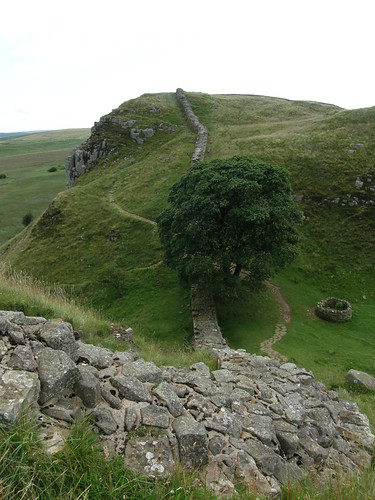Resplendent in freshly laundered gear we climbed the lane from Once Brewed back up to the Wall, pausing only to admire this very obliging butterfly, which I think might be a ringlet. It was already fairly warm, if a little hazy. We would be back at Once Brewed that night, so the kids were able to leave their rucksacks at the hostel, and despite the addition of their water-proofs to my bag, I was able to lighten my load too.
Today’s walk would mostly be more of the roller-coaster ups and downs of the Whin Sill.
Along Peel Crags, overlooked by Milecastle 39….
…to the famous Sycamore Gap, which, as Hollywood knows, is perched on the outskirts of Nottingham.
I’d expected this part of the Wall to be busy, but we had it all to ourselves.
The sun-lit cliff-top walk above Crag Lough was perhaps my favourite single section of our walk. I’ve walked this way before, but I’d forgotten how beautiful it is.
On the climb up Hotbank we were distracted by what, this time, was unmistakably a ringlet…
We were revelling in the views. Back over Crag Lough to Winshields Crags with Cross Fell still dominating in the distance…
…and forward to Broomlee Lough and the final fling of the Whin Sill at Sewingshields Crags, which we would climb later in the day.
To me, this is one of the great pleasures of a linear, multi-day walk: the satisfaction of looking back to distant places already walked through or past or over and likewise the anticipation of looking ahead to landmarks on the route to come.
So the sun shone. We slowly reeled in Sewingshields Crags. It’s a very simple pleasure.
Every so often the Wall threw in a bit of a distraction to give us an excuse for a pause. Milecastle 38 had been an undistinguished mound in a boggy spot on Hotbanks crag. Milecastle 37 was a little more interesting…
Unlike other milecastles we passed, this retains some evidence of internal walls…
…and the remnants of an arched gateway on the northern side.
We did finally meet the crowds, when, at around eleven, we arrived at Housesteads.
We had a lengthy stop here, to watch a short film and examine the exhibits at the museum, take a good look around…
…play a bit of hide and seek….
….lunch on ice cream…
…and cool and dress feet, both children having developed some red spots which suggested rubbing and foreshadowed blisters. Fortunately, a combination of Compeed and surgical tape seemed to do the job and any further problems were avoided.
Soon enough, we were looking back on Broomlee lough….
..and topped out on Sewingshields Crags, at 325m not much lower then our high point of the previous day.
From there a long steady descent to Sewingshields…..
….is followed by Fozy Moss. A slightly rising path, shadowing the road, took us across rather bleak, featureless moorland. It might have been rather dispiriting. In fact we passed several large groups of teenagers, heavily laden and heading in the opposite direction to us, presumably D of E victims, some of whom were singing to keep up their spirits, and some of whom were openly weeping. It was saved for us, bizarrely, by the fact that we regularly had to negotiate wet and muddy ditches running across the path, which the kids found perversely enjoyable.
At Carraw, where the path diverts slightly away from the road around a farm and a small woodland, the flagged path was bordered with nettles and the nettles were festooned with snails.
Rich brown, striped and flecked in pale yellow, I thought they were rather handsome.
I think that they might be copse snails?
I’d originally planned to finish at Chester’s, but it had soon become apparent that this was much too ambitious. That would have made for a much longer day then any of the others and time was against us. Whether we dawdled or, as I thought we had today, generally kept moving, we seemed to pretty consistently manage a mile and a half an hour. So, we chose a new destination: Brocolitia.
Brocolitia is another Roman fort. There isn’t too much to see – the grassy mound on the right of this picture shows how the unexcavated outer walls look. But outside the fort there is a small temple to Mithras, a god popular with Roman soldiers. The site is boggy and the conditions preserved the timber pillars, replaced now with concrete casts, as have been the three altar stones and a small headless statue.
More importantly for us, Brocolitia has a bus-stop for the AD122, which took us back to Once Brewed, where we would eventually get fed and watered and reconvene our card school.





























































































































